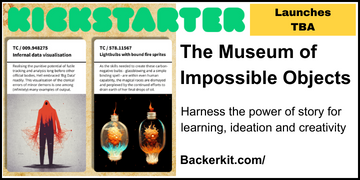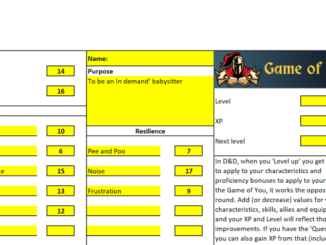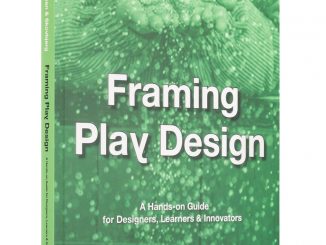
O! for a muse of fire, that would ascend the brightest heaven of invention.
– William Shakespeare
A pile of random game-making materials. Two hour time slot. “Go! Make a game!”
For some, this is oxygen to their designer’s brain, feeding the spark that generates interesting games, but for other game designers like me, this type of game design jam doesn’t work. It’s akin to the blinking cursor on a document when it’s time to write a big paper for school. You know so much about your subject, and you’ve been working so hard to research and compile your ideas, but when it comes to actually starting the work–you blank. You have so many ideas, but which to pick and where to start?
There’s something about the temporary momentousness that can arise in game design jams–the time to design is NOW, with these materials, so procrastination and inaction cannot be entertained. Game design jams are, in the words of Adrienne Ezell, graphic and game designer, “a great way to spark ideation and fast iteration.” Tim Blank, designer, says, “Game jams force us to use a different side of our creative brains that we don’t often use much as designers. We often do a lot of thinking when we iterate on a game, but game jams don’t give us the time to do that. They force us to design by trial and error, which is at the heart of experience design. They also require us to listen to what the game wants to be, as opposed to using our pre-set parameters for it.” Sen-Foong Lim, designer, says, “I thrive under pressure and work well with constraints, so jams are my… jam. I find the pressure cooker of a game jam so refreshing. My brain needs the strict deadline to force it to work on things.” Game design jams, just by existing, can launch designers from ideation to prototyping quickly.

Game design jams shove designers into the heart of the design process, but outcomes are not guaranteed.
Game design jams can have the opposite effect of sparking ideas; they can confound or even stymie them. The pressure of producing a working game in that time frame, whether it’s an hour or eight, coupled with the performative aspect of designing in front of strangers, is productive for some designers, not for others. Elizabeth Hargrave, designer, says, “My personal experience at the one game jam I have participated in was that it confirmed that I hate being forced to be creative in front of people, with time pressure. I’m glad other people enjoy them, am happy to watch, but my brain freezes and nothing comes out.” So how to create a design jam where designers can be successful?

When I was invited to present at Tabletop Network in 2019, I decided to run a game jam, a very specific kind of game jam. I had taught game design to middle school students for 17 years at that point, so I had a good sense of what worked to help others design games. As a teacher and designer, I had undertaken transformative professional development experiences that informed my thinking. The two guiding ideas that shaped my jam were “Bias Towards Action,” and “Fast and Cheap” from the productivity triangle. First, the design mindset “Bias Towards Action,” from the Stanford d.school method of design thinking, means that if you have a choice between thinking and doing, start doing, because you’ll be thinking as you do the work, and you will progress much faster. The second key idea is to avoid preciousness in design by iterating extraordinarily rapidly. Out of Good, Fast, and Cheap, designers can only choose two, and this jam embraces the concept of Fast and Cheap. In such a short amount of time, games won’t be Good, so designers don’t have to worry about that. They just have to make something testable, in any small part, so that they can work towards it being good later. When we spend a lot of time on ideas, they become precious, and often we don’t want to throw out an idea that has had a lot of investment, even with a low amount of payoff. When we develop the ability to toss out non-functional ideas, we get better at developing the ideas that have actual promise. With these ideas in mind, time became the determining factor in shaping the jam.

In a 45 minute session, designers were presented with three game design challenges, ten minutes each. They were provided the specific materials to use for each challenge, and could choose to collaborate or not with other designers. I presented the challenge, distributed resources, and set them off; and then I did it again, and again. I announced the time several times during each challenge to help with pacing throughout. There was no sharing of results afterwards, unless designers chose to do so outside of the session with me or others. I called this event “A Lightning Multi-Game Design Jam.”
Several key decisions guided my design process for the LMGDJ.
- Design and material constraints remove some decision-making from the process to allow focus on other specific aspects of design.
- Ten minutes is not enough time to design a full game, but it can spark an idea that could turn into a full game later.
- If a designer hates any of the challenges or the format itself, at least it’s quick.
Design and material constraints remove some decision-making from the process to allow focus on other specific aspects of design. The first challenge was called, “This Race Game Is in the Bag.” Designers were given a paper bag with sets of bits inside. They could only use the paper bag itself and the bits. Limiting the resources is obvious; I removed choices about what to use, so they could focus just on what was given, not what was possible for components. The race game concept is one of the best I’ve found for helping anyone to design a game for the first time. First, most of the common kid and family games (Candyland, Chutes and Ladders, Sorry, etc) are race games in some way (moving around a track controlled by a randomizer) so it’s familiar structure. Second, race games have the same objective and victory condition–be the first player to cross the line. In providing the objective and victory condition, designers needed only to start with HOW players would move their pieces. By providing specific components and game outcome, designers can focus on the key aspects of the design challenge to iterate quickly workable ideas.
Ten minutes is not enough time to design a full game, but it can spark an idea that could turn into a full game later. The ten minute limitation is the most divisive choice in the design of this event, but in a sneaky way, it also serves to help people succeed. The reality of a game design jam, even for much longer jams, is that creating a full, working game is very difficult to do; and when you don’t create a full workable game in that time, it can really feel like failure. Success in ten minutes isn’t a full game, but is the start of what could be a full game. Success is creating something that might be worthwhile to keep pursuing. Jay Bell, designer, says, “It blows my mind that 10 months after a game jam prompt, I’ve created a solid game outside of my normal genre. Sometimes jams can produce fantastic nuggets, diamonds even.” If designers came away with one really cool idea from each challenge, or even from one challenge, that can be enough to call it successful.
If a designer hates any of the challenges or the format itself, at least it’s quick. If you hate what you are doing in a longer game design jam, you have to spend much longer with that game idea than you might if you were working on something at home on your own terms. The ten-minute limitation allows you a very short tunnel before the light appears to free you from a non-functional challenge. The ten-minute constraint did not work for designer Cat Drayer, who says, “The very short game jams don’t work for me at all, because my brain isn’t ready. If I am inspired in the wild, I can kick out a game idea in seconds, and have done so over and over with loose prompts, but with very tight time pressure, nothing happens.” Cat continues, “A game jam is meant to make you uncomfortable in some way. It should push you out of your normal design zone to try new things. The challenge for me personally is to find how far outside my space I can operate, and the go/no go is currently time. If I haven’t got enough time to digest the prompt, nothing happens.” The time constraint can simply limit designers too much, based on their personal preferences and style.

Designers make choices, and in the Lightning Multi-Game Design Jam, I made specific choices that impacted designers differently. At best, the jam has sparked ideas that became published games; at worst, its format has been too limiting for some designers to generate meaningful game ideas. This format was chosen with very specific goals and outcomes in mind, and certainly there are many other possibilities for design jam spaces. If you are considering designing and running a game jam, the lessons learned from this style of jam can help you to see how employing different ways to use time, resources, and specific design constraints will impact the outcomes for designers.
May the muse of fire ascend your game inventions (and design jams) ever higher.
Appendix:
Since 2019, I have run the LMGDJ online during covid and in person close to ten times, and I’ve adapted the different challenges each time for each audience and setting, while usually keeping the race game challenge as the first. Here is an incomplete list of design challenges that I have used.
Design Challenges
The Race Game is in the Bag
As described above; this challenge was about focusing on HOW a race could be won using provided materials.
The IP Challenge
A real company’s set of characters was to be the basis of a buzzworthy, social-media-friendly game. Designers were given two pieces of cardstock that were the entirety of resources for a flatpack giveaway, so space for rules meant less space for components, and each designer was given a two page dossier on the IP characters for them to use.
The Player Experience Challenge
Designers called out emotions and I picked “Rage.” Using paper and additional components, designers had to create a game that elicited rage from their players.

Happy Valentine’s Day
Make a two-player game based on Valentine’s Day using pennies and index cards. Two player games have great potential for complete interaction between players, and Valentine’s Day can generate a wide range of narratives for games.
Push It!
Designers had to come up with their “entrance song” if they were a professional wrestler or other sports player, and had to design a press your luck game using dice and other components to make a game based on that song. Since entrance songs can generate strong feelings, the idea is to match that feeling to a game that elicits the same, or to draw some other inspiration.
Pick a Direction
Using dice, toothpicks, and meeples, create a game where “Direction” is the driving theme. This was used at an academic conference with a wide variety of audiences from education to corporate, so the theme “Direction” was intentionally chosen to allow a wide range of interpretations, and the components were specifically limited to facilitate quick design ideas.
Think Outside the Box
Using game components and an empty game box, create a game where players must integrate the box into the design itself. I just think game boxes are an underutilized resource.
- Lightning Multi-Game Design Jams - 18th December 2023






Be the first to comment